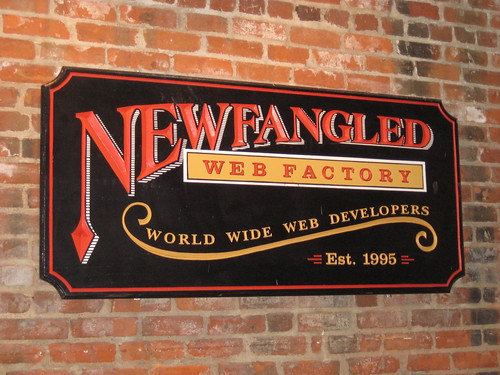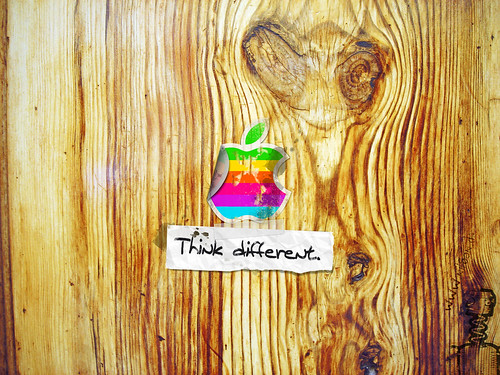 I shouldn’t be writing this post, I should be marking books, reflecting on my Teacher Inquiry, or preparing for my presentation at uLearn09 (hehehe, yep they accepted me! Wooo Hooo) but as my Grandmother would delight in exclaiming … “that man has really put a bee in your bonnet hasn’t he!” and by ‘that man’ I mean Marc Prensky. I am not sure if I am breaking any copy right laws, sorry if I am, but here is the article he wrote that really got my knickers in a twist (another of my Grandmother’s favourites).
I shouldn’t be writing this post, I should be marking books, reflecting on my Teacher Inquiry, or preparing for my presentation at uLearn09 (hehehe, yep they accepted me! Wooo Hooo) but as my Grandmother would delight in exclaiming … “that man has really put a bee in your bonnet hasn’t he!” and by ‘that man’ I mean Marc Prensky. I am not sure if I am breaking any copy right laws, sorry if I am, but here is the article he wrote that really got my knickers in a twist (another of my Grandmother’s favourites).
The article is entitled “Engage Me or Enrage Me” What Today’s Learners Demand. Now before I continue with my rant, I must equivocally express my opinion on digital technologies in the classroom (though if you haven’t guessed from my previous posts by now, I must wonder about your inference skills).
I heart eLearning, bring it on! If it enhances learning it’s going into my classroom programme, if not just give me some time and I will find a way in which it will. Is that clear enough?
I am Pro-eAnything2.0.
However, Prensky’s article has really upset me. He has implied that the only way in which we can truly engage students is through games based learning. I believe that this is a dangerous mantra to evangelise. While many gaming platforms are wonderful learning environments, the majority of Prensky’s reasoning and examples weigh heavily on the negative side of the scales. This article starts alarm bells ringing in my head. I want a digitally enhanced 21 Century classroom. I however, do not want games-based, instant gratification, user-centred classroom Prensky seems to be advocating.
Prensky begins well enough, describing his classic classification of the three types of student us educators would of encountered at one point or another, a fair point but over simplified in my opinion. But then he makes this strange statement when reminiscing over his time teaching in a poor area of New York City.
The big difference from today is this: the kids back then didn’t expect to be engaged by everything they did. There were no video games, no CDs, no MP3s—none of today’s special effects. Those kids’ lives were a lot less rich—and not just in money: less rich in media, less rich in communication, much less rich in creative opportunities for students outside of school. Many if not most of them never even knew what real engagement feels like.
 What does he mean? Did children sit around staring at blank walls not knowing what to do with themselves? How did a child play back then without a control in their hand? How did one play baseball or tennis before the invention of the Nintendo Wii, or sing a song before Sing Star on the Play Station 2? Hmmm how indeed?
What does he mean? Did children sit around staring at blank walls not knowing what to do with themselves? How did a child play back then without a control in their hand? How did one play baseball or tennis before the invention of the Nintendo Wii, or sing a song before Sing Star on the Play Station 2? Hmmm how indeed?
I will not insult your intelligence by describing the childhood past times of the “Digital Immigrant”. But I will question this. What exactly do you consider to be engagement? Is engagement the same as being interested? Is it having fun? How about just paying attention? Or is engagement more than this surface interest? I believe that true educational engagement is a process where by the learner is actively inter-acting with their learning environment, evoking cognitive stimulation from which the learner is able to create their own content with which they share (still thinking and refining this definition).
Prensky’s now goes on to list examples of the ways “All students we teach …” are engaged by various digital wonders. Think very carefully and see if you can count how many of these examples include the student creating their own content through cognitive stimulation. I will add learning intentions to help you.
Here we go:
Downloading Songs – We are learning to create playlists.
Rapping, Lip syncing and Singing Karaoke – We are learning to move our lips in time to music like Brittany Spears.
Mixing our own music or making movies – We are learning to tell a story through music or pictures (well he gets my approval for that one but the rubbish is still winning 2 to 1)
Playing Video Games – We are learning to repeat and repeat and repeat a stage (not unlike rote learning) until we can pass it.
Checking email, IM and talking to my friends – We are learning how to talk to our friends in other ways than just the telephone.
Buying things – We are learning how to spend our parents money.
Playing on a portable console or GameBoy – I am learning how to squint and sit in the shade so the sun doesn’t glare on my small screen.
And finally, this one gets special quotation marks
“…some may do the extreme sports that are possible with twenty-first-century equipment and materials.”(WTF?) – We are learning to bungy jump and parachute after school everyday because my parents are so rich, NOT!
It would seem to me the final score is Rubbish 6; Strange and Unlikely Example 1; and True Engagement 1! Hmmmm
As would seem logical, Prensky goes on to explain that school is not engaging because it does not include gaming (did you know that Prensky is the CEO of a games-based learning company?). School doesn’t have the fast paced action of today’s top selling games. School doesn’t have thrilling battle graphics or the flashing lights or awesome sound effects. Where are the graphics constantly moving on screen? You can’t build your heroes, kill the bad guys, save your friends. You can practise your awesome skills over and over and over again until you clock it, and don’t worry the cheats can help you at the tricky bits, just google them! Shut the curtains, dim the lights (atmosphere …), don’t worry about the time there’s no clock on the console (if you can read the time in the first place), watch that little character running around the screen, it’s almost hypnotising.
Have I ever mentioned that I used to work in a pub? The Whakatane Hotel to be exact, as well as serving on the bar, I also managed the little casino with its eighteen Pokey Machines (Slot Machines for you Americans out there). I once ask one of my very regular customers why he enjoyed playing them (even though he lost more money than he won) his answer surprised me. He said that is was the cool flashing lights, the fun sound effects and “I guess I like watching the way the graphics move on the screen”. Weird?? Those games sure knew how to hook their punters. I didn’t really like being in the Pokey room. It had very small windows, so it was always very dim, the same tunes played over and over again, strangely hypnotic, and it was very frustrating that there was never a clock in there.
I agree that schools need to move forward into the 21st century. I also agree that there are real educational benefits to some gaming platforms. But are all of these games really beneficial? Do they really endow these amazing skills upon the user? Will a child really “master systems ten times more complex than algebra, understand systems ten times more complex than the simple economics we require of them, and read far above their grade level” just because they can clock (to clock a game means to finish it) …
“the three most popular (i.e., best-selling) computer and video games in the marketplace. They were, as of June 2004: City of Heroes, a massively multiplayer online role-playing game; Harry Potter and the Prisoner of Askaban, an action game for the PlayStation 2; and Rise of Nations, a real-time strategy game for the PC.”
Just because a child can Command and Conquer vast nations, vanquish a pack of Dementors and an evil wizard or command a squad of Navy Seals online, doesn’t mean he can do it in real life (and do we really want him to?)
 The final ‘Bee’ in my aforementioned bonnet is that Prensky seems to celebrate, and advocate the engagement of a 4 year old with a complex and graphically violent video game named Halo 2. (Double WTF???).
The final ‘Bee’ in my aforementioned bonnet is that Prensky seems to celebrate, and advocate the engagement of a 4 year old with a complex and graphically violent video game named Halo 2. (Double WTF???).
Prensky explains that
“On a recent BBC show Child of Our Time, a four-year-old who was a master of the complex video game Halo 2 was being offered so-called “learning games” that were light-years below his level, to his total frustration and rage.”
I suggest that the possible frustration and rage this child is displaying has a direct correlation with the amount of heads he has blown off in his tender years (and maybe a lack of sunlight and exercise has contributed?)
While, Prensky does conclude with the statement that “creating engagement is not about those fancy, expensive graphics but rather about ideas” one must still ask the question – Who’s ideas Mr Prensky? The game writers who will create games that provide students with instant gratification? The person who creates a game that students just use and not have to contribute to.
Not once has Prensky explicitly mention Web2.0 and students creating their own content to share and interact with a global learning community. I am sorry Mr Prensky but I do not agree with your view of the digital world! Being a “Digital Native” is about realising that you are an intelligent CONTRIBUTOR, not a ‘give it to me’ USER. (By the way, what’s up with your website Mr Prensky, it’s not very engaging?)




 I have found Wetpaint is an easy to use platform, possibly less finicky than
I have found Wetpaint is an easy to use platform, possibly less finicky than  As you have all probably guessed by now; this post is basically shameless self-promotion on my part. But it is also me feeling a bit guilty for neglecting my blog for this
As you have all probably guessed by now; this post is basically shameless self-promotion on my part. But it is also me feeling a bit guilty for neglecting my blog for this  I shouldn’t be writing this post, I should be marking books, reflecting on my Teacher Inquiry, or preparing for my presentation at uLearn09 (hehehe, yep they accepted me! Wooo Hooo) but as my Grandmother would delight in exclaiming … “that man has really put a bee in your bonnet hasn’t he!” and by ‘that man’ I mean
I shouldn’t be writing this post, I should be marking books, reflecting on my Teacher Inquiry, or preparing for my presentation at uLearn09 (hehehe, yep they accepted me! Wooo Hooo) but as my Grandmother would delight in exclaiming … “that man has really put a bee in your bonnet hasn’t he!” and by ‘that man’ I mean  What does he mean? Did children sit around staring at blank walls not knowing what to do with themselves? How did a child play back then without a control in their hand? How did one play baseball or tennis before the invention of the Nintendo Wii, or sing a song before Sing Star on the Play Station 2? Hmmm how indeed?
What does he mean? Did children sit around staring at blank walls not knowing what to do with themselves? How did a child play back then without a control in their hand? How did one play baseball or tennis before the invention of the Nintendo Wii, or sing a song before Sing Star on the Play Station 2? Hmmm how indeed? The final ‘Bee’ in my aforementioned bonnet is that Prensky seems to celebrate, and advocate the engagement of a 4 year old with a complex and graphically violent video game named
The final ‘Bee’ in my aforementioned bonnet is that Prensky seems to celebrate, and advocate the engagement of a 4 year old with a complex and graphically violent video game named 

 With only one week left in Term Two my classroom blog,
With only one week left in Term Two my classroom blog, 
 Apart from the comment deprivation from the parents, comments from teachers and other classes are growing in momentum. Early on in the life of The Wocket Spot, I decided to add a
Apart from the comment deprivation from the parents, comments from teachers and other classes are growing in momentum. Early on in the life of The Wocket Spot, I decided to add a  comes to a Class Blog that appeals to parents, students and teachers alike. It provides parents with an eWindow into our classroom and allows the kids to continue interacting with their learning. I will keep working on those parents (maybe I need to hire a PR guy) to add comments to our blog, however I won’t be too fussy. Verbal comments are just as good (I can’t share them and show off that’s all) and after all I am doing it for the kids …
comes to a Class Blog that appeals to parents, students and teachers alike. It provides parents with an eWindow into our classroom and allows the kids to continue interacting with their learning. I will keep working on those parents (maybe I need to hire a PR guy) to add comments to our blog, however I won’t be too fussy. Verbal comments are just as good (I can’t share them and show off that’s all) and after all I am doing it for the kids … I am very lucky. I am released an afternoon a week to take a small (4 students) film making group of Year Six (Grade Five) students. Our focus is a current affair style programme that we produce once a term. I modelled this programme loosely on the Selwyn Ridge Primary School, film crew.
I am very lucky. I am released an afternoon a week to take a small (4 students) film making group of Year Six (Grade Five) students. Our focus is a current affair style programme that we produce once a term. I modelled this programme loosely on the Selwyn Ridge Primary School, film crew. As a part of our
As a part of our 
 On Thursday my class and I made our first
On Thursday my class and I made our first  So many questions have sprouted from my grey matter since this experience. “Is it their age?”, “Was it first time jitters?”, then “Is it me?”, “Am I dominating conversations?”, “Should I keep quiet during discussion?” maybe not, because now that I think about it, most of our classroom discussions are heavily reliant on me prompting, questioning, scaffolding and drawing out their thoughts and ideas. This of course goes against my belief that I should be striving to put myself out of a job. I don’t want the kids to be reliant on me, I want them running their own focussed discussions.
So many questions have sprouted from my grey matter since this experience. “Is it their age?”, “Was it first time jitters?”, then “Is it me?”, “Am I dominating conversations?”, “Should I keep quiet during discussion?” maybe not, because now that I think about it, most of our classroom discussions are heavily reliant on me prompting, questioning, scaffolding and drawing out their thoughts and ideas. This of course goes against my belief that I should be striving to put myself out of a job. I don’t want the kids to be reliant on me, I want them running their own focussed discussions.